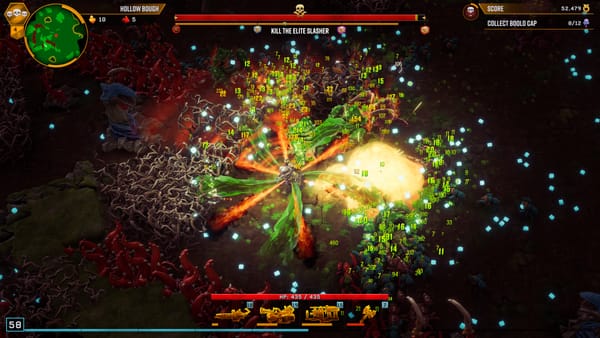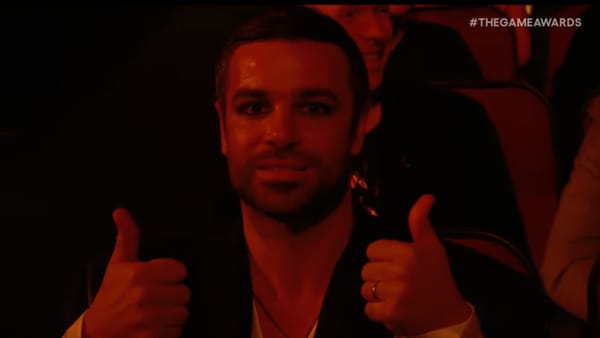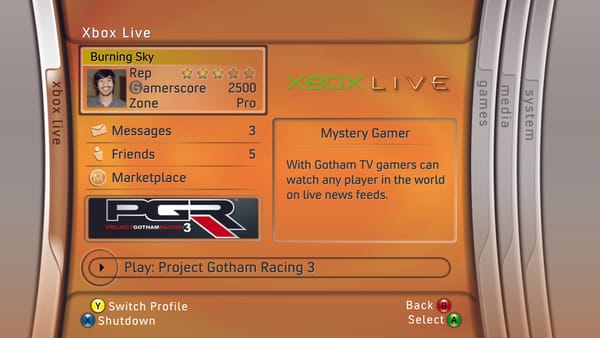#128: The comeback
Live-service developers obsess over user acquisition and user retention. What about those of us in between?
Hello! Before we begin today, some rather important housekeeping. With effect from right now, the cost of a Hit Point subscription is being reduced — yes, reduced! — to £3.50 per month. This, it turns out, is the lowest amount Substack will allow me to charge, and equates to a permanent reduction of over 25 per cent. Cor.
The switch to sterling is largely about making revenue a bit more reliable, less beholden to exchange rate fluctuations, and also because most of my current paying audience is in the UK. To those of you overseas, I suspect this will be a net benefit: the pound has been in the shitter for a number of years now, and I highly doubt the current rabble we have in charge are going to change that any time soon.
I’ll spare you the details of the thought process behind all this. Suffice it to say that $6 feels like a bit too much to ask with everything that’s going on out there at the moment. While the free member list has grown really nicely over the past few months, paid subs have only kept up the pace because of the 20% discount I ran a few weeks back, and that it useful data. (I’d love to pretend I did the discount as a test balloon for a permanent price cut, but I’m just not that smart.) I’m hoping this will give things a bit of a boost ahead of the return later this month of Max HP, the occasional subscriber-exclusive interview series. There may be other changes ahead, but for the time being: it’s cheaper now. That’s nice, isn’t it.
Some finer details, just quickly:
- I’m switching the annual fee to a rough sterling equivalent of the original price, £50, as a sort of hyper-supporter-EX-plus tier for those of greater means or greater love who want to pay more to support Hit Points.
- To current monthly subscribers, the new price should kick in at your next renewal. If you’re on an annual sub and want to switch to monthly when your sub is up for renewal, here’s a Substack tutorial on how to do it.
- If you want to pay even more for some reason, the subscription page has a box for the ‘founder’ tier where you can enter your own amount (it’s set by default to £100 but it can be anything above the annual fee of £50).
- If you’ve recently paid up annually, are cross about the monthly price cut and want a pro-rata refund, reply to this email and let me know and we’ll work something out through my tears.
Three pounds fifty a month! About the price of a decent coffee, and much less than the cost of a good pint. Go on. Make an old man briefly happy.
Right, we’ve written slightly too much about all that, as is tradition. Let’s write slightly too much about something else instead.
I jumped back into Destiny 2 last week, and after a few hours’ play, and a few more reading the subreddit and watching YouTube videos, I have almost got the foggiest idea about what I’ve missed, what’s going on, and what I’m supposed to be doing. I used to play this thing obsessively, religiously. I could probably play a decent number of Strikes with my eyes closed. These days, though? Sheesh. Absolutely clueless.
Where am I supposed to go? What should I do next? Which guns are good these days? What are the four new resources that just flooded the loot feed? What on Earth are all these story bits about? And, most of all: what just killed me? There really are a lot of ways to die in Destiny these days. The game’s community has been saying for a while that the game isn’t hard enough — that only a handful of endgame activities put up enough of a challenge to justify all the hours the committed player spends powering themselves up. And, hey, when your live-service game is a few years old, you naturally need to focus on keeping your most engaged players happy. So, yes. I have no idea what’s going on and I’m dying a lot. Good game though, I think. Shooting the aliens may not be as “fucking relaxing” as it used to be, but the old magic is still in there somewhere for sure.
Destiny’s always had a reputation for being unapproachable, which for most of its life I have thought quite unfair. I was, for several years, able to dip in and out of the game when the mood took me without much issue. But that has changed over the last couple of expansions, and I have come to think of returning to Destiny, or any live-service thing you care to name, after a break as like going back home for Christmas for the first few years after you move away. At first home is warm and comforting, and just how you remember it. You meet some friends one evening and the pub feels like you never left: same faces, same sounds, same beers on tap. But as the years roll by, things change. Your parents, finally free of your roomful of possessions, your mood swings and odd smells, downsize and move across town. Old friends start doing Christmas elsewhere. The pub changes hands, gets a new name and a refurb, jacks up the prices. It all happens slowly, steadily, in barely noticeable increments, until one day it hits you like a truck. Coming home no longer feels like coming home; it’s a reminder of why you left in the first place.
I by no means want to single Destiny out here. It is far from the only game to suffer from this phenomenon; it is just the one I know the best, the one I have loved the most, and therefore the place where I feel the pain most sharply. But it has happened to varying degrees with every successful live-service game I have ever played. I doubt I could ever go back to Apex, or Monster Hunter World, or many of the other service games I have known and loved over the years. I recently logged into Archero, a fun little mobile dungeon crawler that I played quite a bit of during the first lockdown, for the first time in ages and was completely overwhelmed by all the new content, currencies and gameplay systems that had been layered in while I was away. I couldn’t close the app fast enough.
I completely understand a development studio’s instinct to focus the greatest attention on the most engaged parts of a live-service game’s audience. It is they who keep the lights on, and who also shout the loudest. And it’s the one part of a live-service game’s success that the developers themselves have a degree of control over. The other bit, finding new players, is for the biz-dev folks and the marketing team.
User acquisition (UA) is a huge deal for live-service games. The longer a game survives, and the more players it amasses, so the cost of finding each new user rises. On mobile, that’s largely a question of advertising — not just on how much you spend, though you do have to spend more, but on how and where you spend it. This is why mobile games have for several years now been advertised during the Super Bowl, the most expensive ad slot on the planet. They’ve done everything else, and despite the exorbitant cost it is a pretty economically sound way of getting lots of new eyeballs, from some underexplored demographics, on a successful game that’s been around for a few years.
On console and PC, things are more nuanced and tricky. We don’t do in-game advertising (yet). Over the last few years Bungie has tried just about every UA trick I can think of: Destiny has gone (partially) free-to-play, it’s moved from Battlenet to Steam, it’s been on Game Pass and Stadia Pro. We can probably assume that, once the Sony acquisition completes, Destiny will also be part of the nu-PS Plus line-up. Console UA is knotty and weird, and I don’t know what a game like Destiny is supposed to do after it’s done everything available to it. The Super Bowl? Probably not. It works for mobile because everyone’s got a phone in their pocket. Not everyone has access to a high-powered console, or the bandwidth for a cloud service. Sure, a COD or Fortnite can hold its own on the biggest advertising stage on the planet. I’m not sure it’d work for the chasing pack.
All that said, I think live-service games are missing a trick. They seem to think purely in terms of their existing users, and potential new ones. What about people like me? People who used to play the game in question — often to an obsessive degree — but drifted away? It seems fairly logical to me that these people should, in theory, be easier to get back on board than it is to convince a brand-new player to buy, download, install and devote themselves to a game in which they have not previously been interested, despite its success and longevity.
Lapsed players know the game, and know how it feels to love it. They have probably spent money on it in the past. They may even still have it installed! How could you make it easier for them to come back? For them to be able to jump in and quickly get caught up on what’s going on with the story, what all the new activities, currencies, characters and gameplay systems are for, and how best to structure their return to make it as easy as possible for them to fall in love with the game all over again?
Developers know all about the importance of onboarding, but this is a different approach — reboarding, I suppose we could call it — that, if done right, could be as successful as any new platform launch or costly ad campaign. It’s a tough nut to crack, sure, not least because there’s no real precedent for it. But the history of live-service games tells us that, once a game has hit its peak, there is only one direction of likely travel, and it is not a happy one. The first game that bucks that trend might just change the industry forever.
MAILBAG!
Thanks to all of you who got in touch about Monday’s edition, which was a rather downcast look ahead to this week’s not-E3 not-festivities. Here’s a few good ones:
- “I'll say it in hushed tones,” whispers Doc Cylon, “but I can only see the slowing of the near-relentless sense of forward motion that drives E3 as a good thing. I know it's been a trend for a while but so many games release in states that can only be described as 'bad' because they had expectations and timelines to meet that are in many cases set amid the onslaught of hype at E3. I found myself getting detached from it in the years leading up to Covid because I'd frontloaded my expectations with scepticism.” I’m not sure E3 is entirely to blame for this phenomenon — we’ve had plenty of it since E3 faded away, after all — but yes, fair point.
- “For me the best E3 (or not-E3) experiences have always been more about where I was and who I was with, rather than the actual show itself,” writes Ben. “For a number of years I would spend a week with an assortment of friends in the US and it nearly always coincided with E3. You'd inevitably find us gathering around laptops and TVs to collectively watch the main presentations, comment and crack jokes. It was great fun, and that always made for the most memorable E3 experiences.” This is definitely true, and I suppose another thing we’ve lost to the pandemic. These days a friend and I (hi Mikey, love you) watch these things from our respective front rooms, snarkily WhatsApping each other like a latter-day Statler and Waldorf. I love it of course, but it’s no substitute for the real thing. (Hang on a minute. Should I set up a Hit Points Discord in time for not-E3?)
- “I am a perpetual fence-sitter,” writes DeferredPaper in response to the MORE! note on the response to Diablo Immortal, “and I’m afraid that applies here too. I have enjoyed it, and have bought the battle pass. I don't foresee myself paying any more than that, but I am also aware that some people can't control their spending and that games like Diablo are designed to maximise that impulse. And my £4.99, multiplied by a lot of people, is still a huge amount of income for Blizzard. I do struggle to find it evil, though. I suppose it comes down to whether the reward mechanics are close enough to gambling to warrant some regulation. Since some much cleverer people than me in Belgium and Holland have presumably studied this in quite some depth and concluded that they are gambling, then maybe I should do the same. Hey. Turns out I can get off the fence after all!”
Lovely stuff. As ever, hit reply or click the button (that I always come perilously close to forgetting to insert) below, and let’s keep this thing running.
MORE!
- As not-E3 kicks off, the ESA has pledged that actual E3 will return, both in-person and online, in 2023. I’m amazed they managed to get the statement out with Big Geoff’s Converse pressing ever harder on their throat, but you have to wonder if there’s really a way back for real-E3 after what feels like a year too many off the scene. Fingers crossed, obviously. If enough of you do the paid thing, perhaps I’ll be able to fly myself out there.
- Blockchain botherers Gala Games — a name you may recognise from Peter Molyneux’s recently announced dealings with them — have announced that Grit, a game of NFT-powered multiplayer cowboying, is headed to Epic Games Store. Tim Sweeney has boxed himself into a corner a bit with this stuff: you don’t get to be Mr Open Platforms one minute and then say no to NFT nonsense the next, however much you’d like to tell them to sling it. But in a week where the Epic CEO has called in the lawyers over a Fortnite-flavoured crypto scam, the timing of this is pretty unfortunate.
- Saudi Arabia’s Public Investment Fund has put down its bonesaw, picked up its chequebook and bought a $1bn stake in Embracer Group. Cool and normal and good.
- Days Gone developer Bend Studio has unveiled a new logo, and teased details of its new project. “We are currently working on a new IP that includes multiplayer and builds upon the open-world systems of Days Gone,” wrote studio community bod Kevin McAllister, “but brings you a whole new world that we are extremely excited to craft for you.” Firstly, I am not surprised that Bend should be the first PlayStation studio to chart a course through the choppy waters of live services; Sony felt Days Gone underperformed and as such the developer probably didn’t get all that much of a say in the matter when it was time to discuss its next project. Secondly: delighted to see McAllister land on his feet after all the bother he had with those burglars as a kid.
- As a rule, Hit Points doesn’t comment on rumour and speculation. (It has been far too well media-trained.) But it will make an exception for whispers about the imminent announcement of a sequel to the wonderful Dragon’s Dogma. Crossing everything for this one.
There you go! Let us end today with another push for paid subscriptions. I don’t think I can express what I’m trying to do with this thing more elegantly than I did in Hit Points #100, so let’s just borrow that bit then get out of everyone’s way.
“I continue to believe there is a place for game-industry commentary that can entertain and inform, that can be silly and very serious at the same time, that can be deeply personal while also surfacing and examining wider truths about the medium we all love, and the business that surrounds it. That’s what Hit Points does, right? I think that is a good thing to have plop into your inbox two or three times a week, without ads or search optimisation or commercial needs interfering with how I approach the work.”
Couldn’t have written it better myself (hang on, that doesn’t work). Anyway, have a great couple of days and I’ll see you on Friday, for a pick over the bones of Summer Games Fest.





